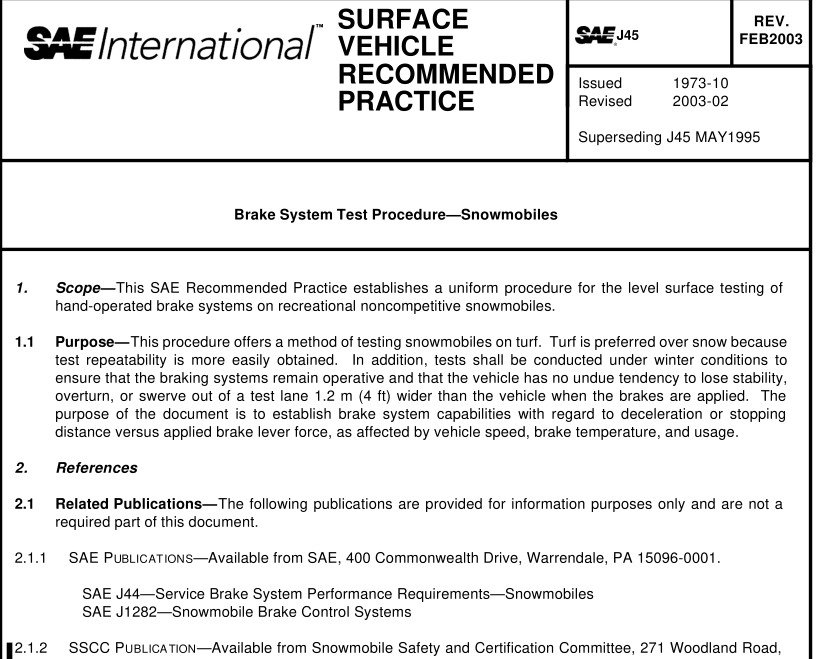SAE J45:2003 pdf download Brake System Test Procedure—Snowmobiles
1. Scope—This SAE Recommended Practice establishes a uniform procedure for the level surface testing of hand-operated brake systems on recreational noncompetitive snowmobiles.
1.1 Purpose—This procedure offers a method of testing snowmobiles on turt.Turt is preferred over snow because test repeatability is more easily obtained. Iln addition, tests shall be conducted under winter conditions toensure that the braking systems remain operative and that the vehicle has no undue tendency to lose stability,overturn, or swerve out of a test lane 1.2 m (4 ft) wider than the vehicle when the brakes are applied. Thepurpose of the document is to establish brake system capabilities with regard to deceleration or stoppingdistance versus applied brake lever force, as affected by vehicle speed, brake temperature, and usage.
2.References
2.1 Related Publications—The following publications are provided for information purposes only and are not a required part of this document.
2.1.1 SAE PUBLICATIONS—Available from SAE,400 Commonwealth Drive, Warrendale, PA 15096-0001.
SAEJ44—Service Brake System Performance Requirements—Snowmobiles
SAEJ1282——Snowmobile Brake Control Systems
sSCC PUBLICATION—Available from Snowmobile Safety and Certification Committee,271 Woodland Road,East Lansing,MI 48823.
sscC 52—Snowmobile Brake Control Systems (Part of SSCC 11—Safety Standards for Snowmobile
Product Certification)
3.Definitions
3.1 Brake Lever Force—A steady force applied in a direction normal to the handle grip in the plane of rotation of the hand brake lever at a distance no more than 25.4 mm (1 in) from the end of the control lever. Refer to5.3.3.
3.2Deceleration—Average rate of change of vehicle speed during stopping time.Numerically equal to the initial vehicle speed divided by the stopping time. Does not denote instantaneous deceleration at some time duringbrake application.
3.3 Average Deceleration—Refers to the average of the previous decelerations over the required number of tests.
3.4 Initial Vehicle Speed—Steady-state vehicle speed immediately prior to brake application.
3.5 Stop Interval—Distance or time between successive brake applications.
3.6 Stopping Distance—Distance vehicle travels from position where brake is applied to position where vehicle comes to a stop.
3.7 Stopping Time—Elapsed time between initial brake application and when vehicle comes to a stop.
3.8 Turf—A consistent and reasonably uniform grassy surface. In this context, does not include root structure.
4. Instrumentation—Instrumentation is required to make the following observations:
a. Brake lever force with an accuracy of ±5%.
b. Specified vehicle speed with an accuracy of ±3 km/h (±2 mph).
c. Actual vehicle speed with an accuracy of ±2 km/h (±1 mph).
d. Stop interval with an accuracy of ±0.1 km (±0.05 mile) on distance, ±5 s on time.
e. Stopping distance or stopping time with an accuracy of ±5%.
f. Current time with an accuracy of ±30 s.
g. Ambient temperature with an accuracy of ±0.5 °C (±1 °F).
h. Deceleration (optional)—may be useful as a guide or indicator.
5. General Instructions
5.1 Brake Assembly—Brakes shall be prepared and adjusted in accordance with the vehicle manufacturer’s standard specifications.
SAE J45:2003 pdf download
